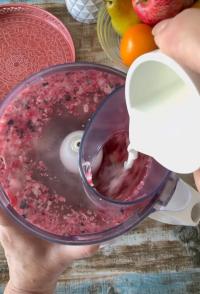Copy Link
Add to Bookmark
Report
Cider Digest #1076

From: cider-request@talisman.com
Errors-To: cider-errors@talisman.com
Reply-To: cider@talisman.com
To: cider-list@talisman.com
Subject: Cider Digest #1076, 17 September 2003
Cider Digest #1076 17 September 2003
Forum for Discussion of Cider Issues
Dick Dunn, Digest Janitor
Contents:
re: finishes and glues (Dick Dunn)
Introduction and some quick questions... ("Dave Halliday")
Franklin County CiderDay ("Bruce D. Popp")
Tannin (km)
Re: Cider Digest #1075, 15 September 2003 (j/kbooth)
Crab Apples ("5585")
the glass as identity ("John Howard")
Juice sources (Richard Nelson)
Re: Cider Digest #1075, 15 September 2003 "Specialty" Ciders ("Nathan Hirn...)
Kingston black apples (Jen)
Send ONLY articles for the digest to cider@talisman.com.
Use cider-request@talisman.com for subscribe/unsubscribe/admin requests.
When subscribing, please include your name and a good address in the
message body unless you're sure your mailer generates them.
Archives of the Digest are available at www.talisman.com/cider
----------------------------------------------------------------------
Subject: re: finishes and glues
From: rcd@talisman.com (Dick Dunn)
Date: Mon, 15 Sep 2003 21:10:07 -0600 (MDT)
Interesting set of responses in CD 1074 to my queries in 1073. Tim Bray,
for example, doesn't buy the "food-safe finishes" concept because they're
essentially all food-safe, while Bill (squeeze) doesn't buy the concept
because they'll all come off eventually anyway! (So the conclusion is use
whatever you want, but it doesn't matter? :-)
Some specific responses--to Tim's comments:
> >(Boiled linseed oil is a notable exception: It is known NOT to
> >be food-safe.)
>
> Where did you hear that?
I've read it in a couple of places in woodworking books.
> Linseed oil has one big advantage, as I see it: It penetrates into the
> wood, rather than forming a surface film, so it doesn't flake or
> chip. Second big advantage is that it is easily renewed. It is true that
> it contains certain metals as drying agents, but these are in such small
> concentrations as to be negligible once the finish has cured in the wood.
I'd have to be convinced that they're negligible, particularly since the
comments I've seen explicitly call out boiled linseed oil as unsafe. I
might wonder if the drying agents are still based on heavy metals, since
so much has changed in the past 20 years or so in terms of material safety.
> Its chief drawbacks are that it takes a very long time to fully cure
> (probably a month), and it provides very little moisture protection...
Are you sure you're talking about boiled, not plain?
> I wouldn't recommend _any_ finish, actually - the conditions are so adverse
> that you're better off using a rot-resistant wood, like white
> oak. (Barrels aren't finished on the inside - why worry about your press?)
White oak is fine. I'd been thinking that I might not want that much
"wood" in the cider, from what it would pick up for the first few batches
across any new wood. (That would be more of a concern for pressing for
fresh juice than for juice intended for cider.) After a bit it would
probably be negligible.
Also a couple of comments on Bill's notes:
> ... in
> cases like the grinder drum being wood, it's most likely a hardwood [oak]
> that isn't absorbant,...
Make that specifically "white oak".
>...so shouldn't be a problem w/ no finish ...
OK, the two of you have convinced me.
One of the reasons for finishing wood (e.g., in the common HVR press) is
when you're supplied with pieces that are in contact with the juice but are
*not* white oak. There's not just the matter of resistance to moisture;
there's the taste. Some woods taste funny.
> ...as for glues, I can't imagine any glue
> standing up to the particular acidity of apple juice over long periods.
That would rule out making some parts out of wood, as it can be tough to
find anything thicker than 8/4 that's decently dried and doesn't cost a
king's ransom.
> ...press racks are easily
> made of HMD polyprop sheets, grooved 1/2 thru in opposite directions each
> side...
That's a good idea, but where do you get the material? The stuff I've seen
(actually labeled as UHMW - is that the same as what you mean?) tends to be
strips or narrow sheets, and is expensive.
- - - -
Dick Dunn rcd@talisman.com Hygiene, Colorado USA
------------------------------
Subject: Introduction and some quick questions...
From: "Dave Halliday" <dh@synthstuff.com>
Date: Mon, 15 Sep 2003 22:08:38 -0700
Lurking for a month or two - time to de-cloak :-)
My wife and I just purchased 31 acres of land in Maple Falls near Mount
Baker in WA State. Having done homebrew for a while, we are looking at
doing a small commercial hard cider operation. Planning to plant a
couple acres of trees next spring and ramping up to about ten acres of
specialty apples in a couple years. Kingston Black and Foxwhelp are our
two first choices.
We will buy apple juice from other growers to make up the balance.
Looking at doing a blended draft cider for tap sales and also (later)
doing a wine-bottled higher-octane/higher-price product for sale in
local stores and restaurants.
Questions:
Are their any books that people would recommend?
I got a copy of "Fermented Beverage Production" from Amazon and it is
wonderful. I also have a bunch of my home-brew books - George Fix's
stuff, etc... What we are looking for are books on orchard work. Jen
comes from a 5th-generation farm family so she has a lot of the basic
knowledge but she doesn't have direct experience with commercial apple
tree growing. We plan to check with the Western Washington University
people as well as local resources but for now, I am looking for book
titles that will get us pointed in the right direction regarding orchard
management and the general care and feeding of apple trees.
How to do the Federal paperwork?
The WA State paperwork seems to be straightforward. The Federal website
is a bit opaque - should we hire a lawyer to run the paperwork through?
We have both run businesses in WA state (sole-proprietorship and
corporation) so the basic daily paperwork should be straightforward but
setting this up seems a little daunting right now.
Thoughts or suggestions?
Thank you all!
Dave
------------------------------
Subject: Franklin County CiderDay
From: "Bruce D. Popp" <vze2r2q3@verizon.net>
Date: Tue, 16 Sep 2003 08:14:37 -0400
Terry,
Thanks for sharing information on the 9th Annual CiderDay. The web link
that you provided doesn't say who is selling cider for immediate consumption
and who is selling cider blends for fermentation. Could you help clarify
who's who?
Bruce
------------------------------
Subject: Tannin
From: km <marshall@maritime-photos.com>
Date: Tue, 16 Sep 2003 14:39:48 +0200
I see that some of you that do not have access to high-tannin apples are
adding tannin to your juice. What type of tannin are we talking here?
Its my understanding that tannin isn't just tannin. I have access to a
powder called "acidum tannicum". Is that acceptable?
Kurt Marshall
------------------------------
Subject: Re: Cider Digest #1075, 15 September 2003
From: j/kbooth <jameshbooth@worldnet.att.net>
Date: Tue, 16 Sep 2003 09:08:03 -0400
I've used raisins in cider recipes and just plunked them
in. However, I've wondered if sending them thru a food
mill to coarsely grind them wouldn't improve the extraction.
Any thoughts? After all we don't dump in whole grapes
to make wine. jbooth
------------------------------
Subject: Crab Apples
From: "5585" <5585@email.msn.com>
Date: Tue, 16 Sep 2003 08:11:06 -0700
Can anyone recommend their favorite Crab apple to plant and use in
cider.
Thanks
Tim Taylor
------------------------------
Subject: the glass as identity
From: "John Howard" <jhoward@beckerfrondorf.com>
Date: Tue, 16 Sep 2003 11:22:07 -0400
As Dick points out, many glasses are associated with particular beverages.
There is often a functional relationship to the form. The broad belly of a
snifter is intended to maximize the surface area of the brandy or port to
boost evaporation and then concentrate the resulting aromatic qualities at
the narrow rim. One's fingers slip nicely around the short stem and the
evaporative process is aided by the warmth of the palm against the bottom of
the glass. The same is true of wine glasses only the stem is longer to
avoid warming the wine with your fingers.
The Arturians use a wide mouthed vessel for their cider. The wide mouth
functionally accommodates their acrobatic pouring technique which involves
holding the bottle high over your head and the glass below the waist,
preferably while carrying on a conversation with another table and making
eye contact with an attractive female across the room. This is done to get
lucky and impart a temporary petulant quality to an otherwise still cider.
The filled cup is quaffed post haste.
I've read that the French, inexplicably, use an opaque vessel for enjoying
their beautiful ciders.
According to Joan Morgan & Alison Richards, in their wonderful "The Book of
Apples", Lord Scudmore, an early 17th century English cider connoisseur,
pioneer of bottled cider, discoverer and promoter of cider apples, used a
tall narrow specially designed cider flute, similar to what we think of as a
champagne flute. Apparently he was not alone in adopting this form as the
proper glass for cider. This makes functional sense as it would give a nice
view of the cider's color, put the tiny bubbles on display, keep unwanted
warming fingers down on the stem, and gives a concentrated area at the top
of the glass for enjoying the relatively delicate bouquet of cider. I
recently found some nice old tulip-shaped champagne flutes that answer this
description and have adopted them for use when pushing cider on my
ever-patient dinner guests but I still take my daily cider in a small
straight sided juice glass.
John Howard
Philadelphia PA USA
------------------------------
Subject: Juice sources
From: Richard Nelson <rgnelson@worldnet.att.net>
Date: Tue, 16 Sep 2003 17:23:52 -0500
Hello,
I'm new to the Cider Digest and brewing cider. I have brewed beer for the
past eight years or so.
Trying to get organized for the first batch of cider this fall.
I've read Correnty, Proulx & Nichols, and Andrew Lea.
I'm also reading the Digest archives.
I do not have an orchard and need to locate a source for juice. Does anyone
have suggestions/recommendations for source(s) anywhere in Massachusetts or
New England for that matter?
Thank you,
Dick Nelson
Dover, Massachusetts
------------------------------
Subject: Re: Cider Digest #1075, 15 September 2003 "Specialty" Ciders
From: "Nathan Hirneisen" <cave_nate@hotmail.com>
Date: Tue, 16 Sep 2003 23:19:20 -0400
I used about one teaspoon pumpkin pie spice per a gallon of cider. pumpkin pie
spice is available in grocery stores pre mixed, it consists of dried ginger,
cinnamon, allspice, and nutmeg. It was added to the post racked cider before
it was let to age. that gave a fairly strong flavor. I'd reduce the spices
by 1/2 for my tastes.
Nate
Subject: "Specialty" Ciders
From: km <marshall@maritime-photos.com>
Date: Fri, 12 Sep 2003 13:21:06 +0200
Hi All,
I was wondering if any of you had much experience with putting raisins
in cider. I am using 30 liter carboys and would be interested to know a
rough estimate of how much (many?) raisins to put in. Any tips? Plusses?
Drawbacks?
Also, I am interested in making a ginger specialty cider. I have a very
nice batch from last year which tastes like an apple prosecco and I
thought that with a hint of ginger this could be a terrific summer
drink. Have any one of you ever made a ginger cider before? If so, how
did you do it? I have thought about sterilizing ginger root slices in a
pressure cooker and then putting them in the carboy in a cheesecloth bag
but Im also a bit baffled as to how much to use. I dont want to
overpower it with ginger. If anyone has ever done this Id be very
interested in hearing details.
Kurt Marshall
Hamburg, Germany
------------------------------
Subject: Kingston black apples
From: Jen <jclaster@localnet.com>
Date: Wed, 17 Sep 2003 07:17:06 -0400
I just established a small apple orchard this year which includes a few
Kingston Black trees on M9. All season long the new leaves on the KB
have had a dark purple hue to them, something I normally associate with
a nutrient deficiency. However, nearby trees of other varieties do not
exhibit this. Anyone else who has grown KB's- are they susceptible to
nutrient deficiency or are their leaves just purple?
Jason MacArthur
Zone 4b
Marlboro, Vt
------------------------------
End of Cider Digest #1076
*************************



























